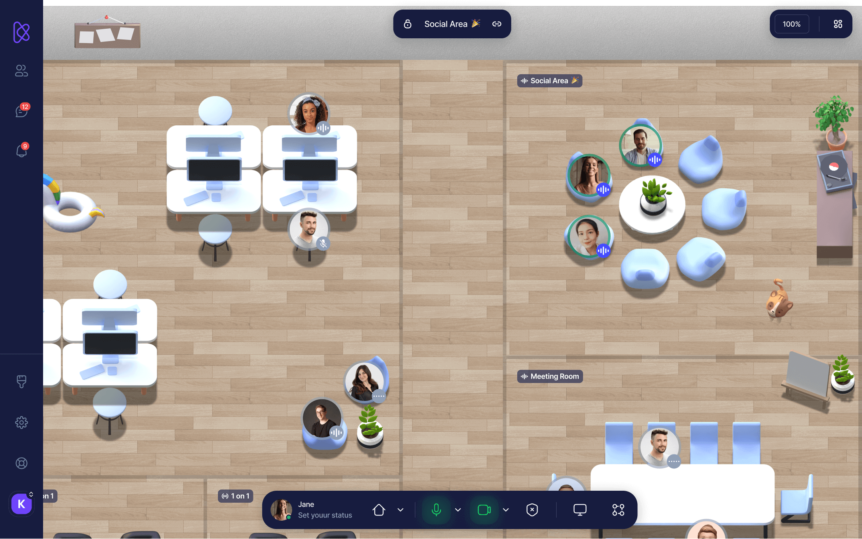The term “metaverse” is often used to describe a collective virtual shared space, in which users create and inhabit digital worlds. The metaverse is a concept first imagined by science fiction authors and later adopted by technology enthusiasts for its potential future applications. In recent years, the metaverse has gained increased attention as more tech companies have been working to create virtual worlds for their users.
At the core of the metaverse is the idea of fungible tokens, also known as cryptocurrencies. These cryptocurrencies are stored and traded digitally, allowing users to buy and sell digital assets in-game or across multiple games using a common currency. This means that not only can you purchase virtual items but you can also purchase real estate, cars, jewelry, and other virtual assets for use within the metaverse.
The metaverse is also home to many walled gardens, which are areas with restricted access and limited availability of resources. These walled gardens can be accessed only by those who have been granted special permission or purchased a membership. For example, the popular virtual world Second Life is a walled garden that only allows members to access certain areas and activities.
The metaverse can be accessed via virtual reality headsets, computers, or other devices. Users may create their own avatars and explore vast 3D landscapes and build relationships with other users in real-time. These virtual spaces have been used for various purposes including business meetings, educational activities, and even video games.
Recently, several companies have begun to explore the potential of the metaverse. Facebook CEO Mark Zuckerberg recently announced that his company is developing an open-source platform with mixed reality elements called Horizon. This platform will allow users to create their own virtual spaces and engage in various activities, such as watching videos, chatting with friends, and playing video games.
The metaverse is an exciting concept that has only just begun to take shape as more companies explore its potential. With the development of virtual reality technology and advances in real-time video gaming, the virtual world may soon become a fully integrated part of our everyday lives. As this technology continues to evolve, the metaverse may soon become as real and engaging as the real world.
World Wide Web Metaverse
The World Wide Web Metaverse is an emerging technology that is rapidly becoming more popular and accessible. It is a virtual, 3D world where users can interact with each other and access various services such as shopping, gaming, education, entertainment, and communication.
It has been described by some analysts as the next big thing after the Internet, as it combines the features of a 3D virtual world with those of an online social network. In the Metaverse, users can create their own avatars and navigate around in a virtual environment that is constantly changing and evolving.
The Metaverse also has a variety of different applications that allow users to do things like shop, learn, play games, collaborate on projects, and more. These applications are all connected and integrated, giving users the ability to access a variety of services and information from one place.
The World Wide Web Metaverse is quickly becoming an important part of our lives, as more people use it every day. It has the potential to revolutionize the way we communicate, collaborate, and interact with each other in ways that were never before possible. As technology continues to develop and evolve, it will only become more powerful and popular.
The Metaverse and the Workplace
The workplace of the future is rapidly changing, and companies all over the world are embracing a new kind of remote, virtual presence to stay competitive. One way many businesses are doing this is by implementing a metaverse into their operations. The metaverse is an online space where employees, customers, and other stakeholders from around the globe can interact in a virtual world.
Zoom Spots is one of the first companies to offer this type of technology, allowing users to create fully immersive 3D environments for their remote meetings and conferences. KOSY and ROAM are two other metaverse-based companies that have recently emerged, providing similar solutions. These platforms allow users to access 360-degree, virtual reality spaces where they can interact with each other through avatars, making it feel like they are in the same room.
Metaverse-based solutions provide several benefits to businesses, including increased productivity and collaboration. With these platforms, teams are able to work together on projects in real time and have access to a wide range of resources and tools. Additionally, they can create virtual spaces that allow for more natural conversations as if they were all in the same room, creating a sense of presence and connection within remote teams.
The metaverse is rapidly changing the way businesses operate – making remote work easier than ever before. With its ability to bridge gaps between distant teams, it is becoming an increasingly popular way for companies to stay connected, productive, and competitive in the modern workplace.
What is a Defining Feature of the Metaverse?
The defining feature of the Metaverse is its ability to create persistent virtual worlds that allow users to interact with each other in ways not possible within traditional online and offline settings. The Metaverse isn’t just a collection of gaming environments, either. It’s an expansive social platform that encourages cooperation and innovation between its members. Through this platform, participants are able to create and enjoy experiences that are completely unique.
Within the Metaverse, users can construct virtual avatars that represent aspects of their individual personalities. These avatars allow people to explore and develop within a digital environment, while still being part of a larger community. Through this system, individuals can have meaningful interactions with one another by contributing to the shared experience.
Moreover, the Metaverse encourages collaboration through its many collaborative tools. These range from basic chat rooms to more sophisticated systems like virtual reality and augmented reality glasses technology. People are also able to build their own custom environments within the Metaverse and share them with others. This gives individuals an opportunity to create and experiment with creative concepts that they wouldn’t otherwise be able to in a traditional setting.
So, if you’ve ever wondered what is so special about the Metaverse, just know that it’s a platform that encourages collaboration and innovation while allowing users to create unique experiences tailored to their individual needs. With the Metaverse, people are given an opportunity to connect with each other in ways never thought possible before. It is truly a defining feature of this ever-evolving world we live in.
Developed Technologies
The metaverse has seen a number of technological advancements since its inception, allowing for more immersive and interactive experiences. Virtual reality (VR) is becoming increasingly popular thanks to headset technology such as the Oculus Rift and HTC Vive, which allow users to explore 3D virtual worlds with realistic visuals, audio, and motion tracking. Augmented reality (AR) technology is also being used to overlay digital content onto the physical world, providing an even more immersive experience for users.
In addition, artificial intelligence (AI) and machine learning are being adopted in the metaverse to create more dynamic experiences that react to user input and generate smarter environments with greater levels of complexity. AI-driven bots and virtual agents can help users navigate the metaverse and provide assistance with tasks.
Finally, blockchain technology is being used to power the underlying infrastructure of the metaverse by providing secure digital identities for users and verified transactions between participants in a shared environment. This helps to ensure that data is kept safe and allows for a decentralized economy where companies can transact directly with customers.
Overall, the advancements in technology have enabled the metaverse to become a more immersive and interactive digital space for users to explore and engage with others across the globe. These emerging technologies are driving forward the development of next-generation virtual worlds that will continue to revolutionize how people interact and do business online.


